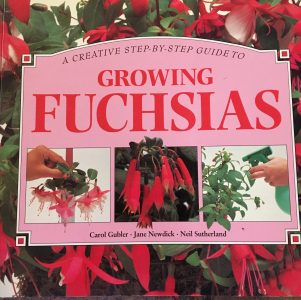Fuchsias are a summer garden favorite for so many of us Fairbanks folks. Yet, we enjoy them during our summer months and wait until the next season to begin them again. On a quest to extend their lifespan, I’m trying to overwinter them. One resource I’m using is a Creative step-by-step guide to Growing Fuchsias, by Carol Gubler, Jane Newdick, and Neil Sutherland (Whitecap Books, 1994). A bit dated, but still a great resource for fuchsia lovers.
This book has great advice and illustrations on choosing a good plant, as well as standard advice on watering, pests, fertilizing, shaping and pruning. Although it’s not Alaska specific, the advise combined with Alaska sources is worthwhile. Bad plants show signs of rust on the leaves, pinched out too far up the stem, and have become root bound. Good plants look bushy and shapely.
Preparing your plants for an Alaskan winter requires pruning back to woody stems. Remove the largest branches first and then the smaller branches to create the shape you want. Clean away any debris on the plants to prevent botrytis and damping-off. Store in a cool location, between 35 – 50 degrees. Two methods of overwintering provided are swaddling in lightweight fleece or placing the plant in a cardboard box and filling with polystyrene foam or wood chips. Keep the plants in a dark environment but do not let them dry completely out.
February is the month to bring them out. if the plants were stored in an area that was too warm, there will be new growth that will be white and spindly, In this case, prune off the new growth rather severely to give a nice bushy basket for summer. If there are no visible growth buds, you should check to see if the plant is still alive. Scratch the bark with a fingernail to see if the cambium layer is green. If not, the plant is probably dead and needs to be replaced. If it is still alive, repot, remove any dead branches, and prune excessive growth, both old and new.
Whether you start with new plants or those that have been wintered over, fuchsias require pinching for the bushiest plants. This does not hurt the plants and will result in a bushier basket. The more pinching, the more branches you have. The more branches, the more bosoms will be produced. The last pinching should be done in May. The book has great illustrations on pinching methods.
Sage advice is given on growing fuchsias indoors as they are not the ideal houseplants in Alaska. It is best to start them indoors from a small cutting so that it becomes used to the indoor environment. This is safer than expecting an outdoor plant to suddenly adjust to a big change. Fuchsias are high maintenance because they expect to be misted and turned regularly. It’s best to start with a short jointed, compact variety for a houseplant.
I’m going to be experimenting with overwintering this Swingtime Fuchsia. Wish me luck!


So, how did the plant survive?